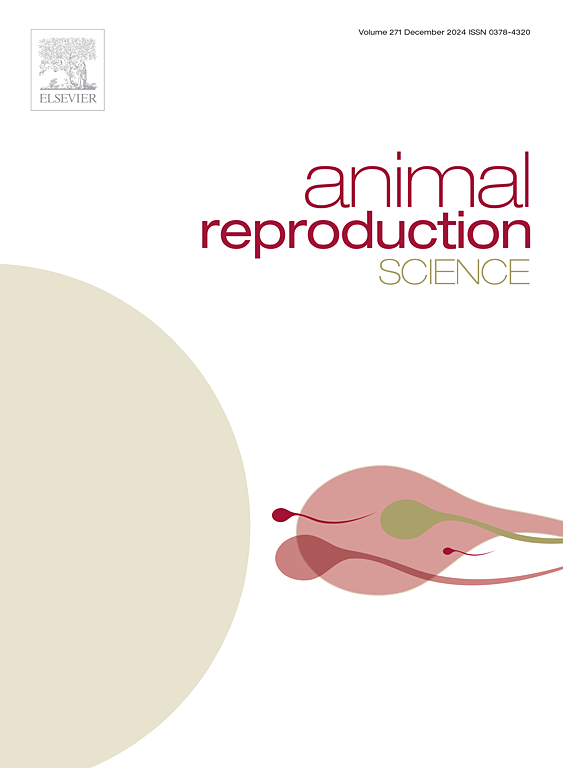长链脂肪酸通过线粒体β氧化促进解冻后猪精子ATP的产生
IF 3.3
2区 农林科学
Q1 AGRICULTURE, DAIRY & ANIMAL SCIENCE
引用次数: 0
摘要
由于目前猪精液冷冻保存系统的局限性,解冻后精子质量的有效恢复仍然是一个重大挑战。本研究探讨解冻后的公猪精子是否能吸收外源长链脂肪酸(LCFAs)并利用其生成ATP,从而维持精子的线性运动,增强精子活力。在添加不同浓度的脂质混合物(0、0.01 %、0.1 %和1 % LM)的扩展液中稀释猪精液。在冷冻保存和随后的解冻后,评估精子的关键参数,包括活力、活力、顶体完整性、线粒体膜电位(MMP)和ATP水平,以及苹果酸脱氢酶(MDH)、琥珀酸脱氢酶(SDH)和肉碱棕榈酰基转移酶-1 (CPT-1)的酶活性。与对照组相比,添加0.1 % LM显著提高了解冻后精子活力,改善了精子活力和顶体完整性(P <; 0.05)。该浓度还导致MMP增加,ATP水平升高,MDH、SDH和CPT1活性增强(P <; 0.05)。此外,为了进一步验证解冻后的猪精子利用LCFAs通过线粒体β氧化产生ATP。结果发现,添加100 μM线粒体β-氧化抑制剂埃托莫西显著降低解冻后猪精子的进行活力、MMP、ATP水平和CPT1活性(P <; 0.05),从而减弱了外源LCFAs补充的有益作用。这些结果表明,解冻后的猪精子能够吸收外源LFCAs,从而促进线粒体β-氧化,增加TCA循环活性和ATP的产生,从而提高解冻后的猪精子的质量。本文章由计算机程序翻译,如有差异,请以英文原文为准。
Long-chain fatty acids promote ATP production in post-thaw boar sperm through mitochondrial β-oxidation
Due to the current limitations of boar semen cryopreservation systems, the effective restoration of sperm quality following thawing remains a significant challenge. This study investigates whether post-thaw boar sperm can uptake exogenous long-chain fatty acids (LCFAs) and utilize them for ATP generation, thereby sustaining linear motility and enhancing sperm vitality. Boar semen was diluted in extender solutions supplemented with varying concentrations of a lipid mixture (0, 0.01 %, 0.1 %, and 1 % LM). Following cryopreservation and subsequent thawing, key sperm parameters were assessed, including motility, viability, acrosome integrity, mitochondrial membrane potential (MMP), and ATP levels, as well as the enzymatic activities of malate dehydrogenase (MDH), succinate dehydrogenase (SDH), and carnitine palmitoyltransferase-1 (CPT-1). Compared to the control group, supplementation with 0.1 % LM significantly enhanced post-thaw sperm motility and improved viability and acrosomal integrity (P < 0.05). This concentration also led to increased MMP, elevated ATP levels, as well as enhanced activities of MDH, SDH, and CPT1 (P < 0.05). Furthermore, to further verify that post-thaw boar sperm utilize LCFAs to generate ATP through mitochondrial β-oxidation. It was found that adding 100 μM mitochondrial β-oxidation inhibitor etomoxir to the extender, significantly reduced post-thaw boar sperm progressive motility, MMP, ATP levels, and CPT1 activity (P < 0.05), thereby attenuating the beneficial effects of exogenous LCFAs supplementation. These findings suggest that post-thaw boar sperm are capable of assimilating exogenous LFCAs, which subsequently promote mitochondrial β-oxidation, increasing TCA cycle activity and ATP production, therefore improving the quality of post-thaw boar sperm.
求助全文
通过发布文献求助,成功后即可免费获取论文全文。
去求助
来源期刊

Animal Reproduction Science
农林科学-奶制品与动物科学
CiteScore
4.50
自引率
9.10%
发文量
136
审稿时长
54 days
期刊介绍:
Animal Reproduction Science publishes results from studies relating to reproduction and fertility in animals. This includes both fundamental research and applied studies, including management practices that increase our understanding of the biology and manipulation of reproduction. Manuscripts should go into depth in the mechanisms involved in the research reported, rather than a give a mere description of findings. The focus is on animals that are useful to humans including food- and fibre-producing; companion/recreational; captive; and endangered species including zoo animals, but excluding laboratory animals unless the results of the study provide new information that impacts the basic understanding of the biology or manipulation of reproduction.
The journal''s scope includes the study of reproductive physiology and endocrinology, reproductive cycles, natural and artificial control of reproduction, preservation and use of gametes and embryos, pregnancy and parturition, infertility and sterility, diagnostic and therapeutic techniques.
The Editorial Board of Animal Reproduction Science has decided not to publish papers in which there is an exclusive examination of the in vitro development of oocytes and embryos; however, there will be consideration of papers that include in vitro studies where the source of the oocytes and/or development of the embryos beyond the blastocyst stage is part of the experimental design.
 求助内容:
求助内容: 应助结果提醒方式:
应助结果提醒方式:


